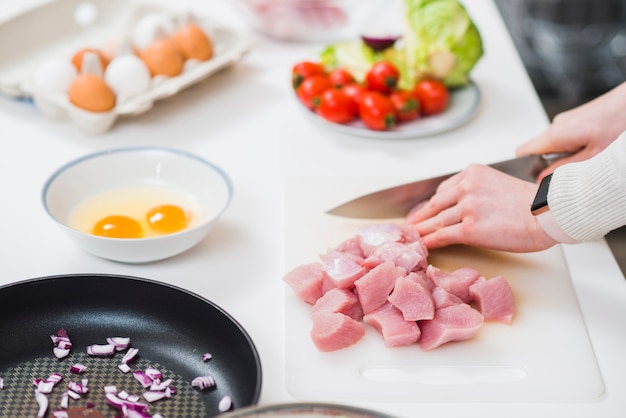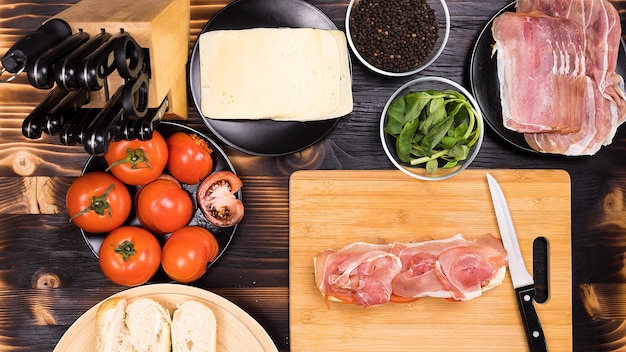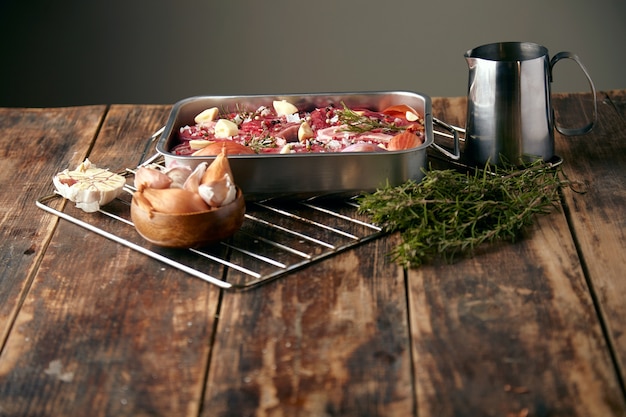Ah, ham. The salty, smoky aroma, the tender texture, the versatility – there's a reason it's a staple at holiday gatherings and a beloved ingredient in countless recipes. I've always had a soft spot for a good ham, whether it's a glistening Christmas ham, a sweet-glazed Easter ham, or just a simple ham sandwich for lunch. But, as much as I adore ham, I know its deliciousness comes with a responsibility – food safety. No one wants a foodborne illness, especially from something as tempting as a juicy ham. So, I've made it a point to diligently check the internal temperature of my ham before indulging.
My earliest memories of ham involve helping my Mum prepare Christmas dinner. We had a magnificent, succulent ham, ready to be carved and devoured. My young self was itching to taste it, but Mum insisted on using a meat thermometer first. The ham, to my disappointment, wasn't quite cooked through. Mum explained, with patience and a touch of firmness, that it was crucial to cook the ham thoroughly to avoid any unpleasant surprises. Since then, I've always held that lesson close, ensuring that the internal temperature of my ham reaches the safe mark before I take a single bite.
Over time, my culinary knowledge has grown, and I've come to understand that cooking ham to the right temperature isn't just about avoiding a mild stomach upset, it's about preventing serious illness. Therefore, if you're planning on cooking a ham, make sure to follow these guidelines. Let's delve into the world of ham safety and ensure you serve a delightful and secure meal.
(Part 1) The Vital Role of safe internal temperature

When it comes to cooking ham, internal temperature is paramount. It's not just about achieving a cooked-through texture, but it's about eliminating harmful bacteria that can lead to food poisoning. I've seen the unpleasant effects of food poisoning firsthand, and trust me, it's not a pleasant experience. That's why I treat food safety with utmost seriousness.
Why is Internal Temperature So Critical?
Ham, like many other meats, can harbor bacteria like Salmonella and Listeria. These bacteria can flourish in warm conditions, and if the ham isn't cooked to a safe internal temperature, these microorganisms can survive and multiply, causing significant discomfort.
Thankfully, these harmful bacteria are easily eliminated by cooking the ham to a sufficiently high temperature. That's why using a meat thermometer to check the internal temperature of your ham is essential. It's the only way to be absolutely sure that your ham is safe to eat.
(Part 2) Unmasking the Safe Internal Temperature for Cooked Ham

You might be wondering what the magical temperature for cooked ham is. Well, I'm here to shed light on that! According to the UK's Food Standards Agency, the safe internal temperature for cooked ham is 71°C (160°F). This temperature ensures that any harmful bacteria present in the ham are effectively eliminated, making it safe for consumption. Now, some people might share anecdotes about cooking ham at a lower temperature without any ill effects, but it's important to remember that there's always a risk involved with undercooked meat. Playing it safe is always the best course of action, so always cook your ham to the recommended temperature.
(Part 3) Decoding the Art of Checking the Internal Temperature

Now that you know the target temperature, let's talk about how to actually measure it. That's where our trusty meat thermometer comes into play. I always keep a meat thermometer handy in my kitchen, and I highly recommend you do the same. It's a small investment that can save you a lot of worry and potential health issues.
Choosing the Right Thermometer: A Guide to Accuracy
You'll find various types of meat thermometers available, but the most common and reliable ones are instant-read thermometers. These thermometers feature a probe that you insert into the thickest part of the ham. Within seconds, the thermometer will display the internal temperature. When selecting a thermometer, make sure it's accurate and easy to use. A thermometer that's difficult to read or unreliable won't be helpful.
Mastering the Thermometer Placement: Finding the Sweet Spot
When checking the temperature of your ham, precise placement is crucial. Aim for the thickest part of the ham, usually found in the centre. Avoid inserting the thermometer near bones or fat, as these areas can provide inaccurate readings. Insert the thermometer deep enough to ensure it's measuring the internal temperature accurately.
(Part 4) Unlocking the Secrets of ham cooking
Let's dive into some valuable tips for cooking ham. Cooking ham can seem daunting, especially for beginners, but with a bit of practice and these tips, you'll become a ham-cooking maestro in no time.
The Importance of Thoroughly Cooking Your Ham
First and foremost, always ensure your ham is cooked through. Resist the temptation to undercook it, even if it appears done. It's always better to be safe than sorry, especially when it comes to food safety. And remember to double-check the internal temperature with your trusty meat thermometer.
Avoiding Cross-Contamination: A Crucial Step in Food Safety
Cross-contamination, the transfer of harmful bacteria from raw meat to cooked food, is another vital factor to consider. To prevent cross-contamination, thoroughly wash your hands with soap and water after handling raw ham. Also, use separate cutting boards and utensils for raw and cooked meat. This simple precaution can make a significant difference in food safety.
Storing Your Ham with Care: Safeguarding Your Delicious Creation
Once your ham is cooked, proper storage is vital to prevent bacteria growth. If you're not serving the ham immediately, refrigerate it as soon as possible. Always refrigerate cooked ham within two hours of cooking. Make sure the ham is properly wrapped in plastic wrap or aluminum foil to prevent drying out. And when reheating the ham, ensure it's heated thoroughly to an internal temperature of 71°C (160°F).
(Part 5) Navigating the World of Ham Varieties
We've discussed ham in general terms, but did you know there are different types of ham available? Understanding these variations can influence how you prepare and cook them, so it's crucial to be aware of these distinctions.
fresh ham: A Canvas for Culinary Creativity
Fresh ham is a type of ham that hasn't been cured or smoked. It's typically sold raw and needs to be cooked thoroughly to a safe internal temperature. Fresh ham is often used in recipes where it's braised, roasted, or baked.
cured ham: A World of Flavor and Preservation
Cured ham is a type of ham that has been preserved using salt, sugar, and sometimes nitrates or nitrites. This process helps extend the shelf life of the ham and imparts a distinct flavour. Cured ham can be further categorized as:
- dry-cured ham: This type of ham is cured for an extended period, typically several months, and then air-dried. It has a very intense flavour and is often served thinly sliced. Think prosciutto or Jamón Ibérico.
- wet-cured ham: This type of ham is cured in a brine solution, which is a mixture of water, salt, sugar, and other ingredients. Wet-cured ham is typically cured for a shorter period than dry-cured ham and is usually cooked before eating.
smoked ham: A Symphony of Flavor and Aroma
Smoked ham is a type of ham that has been cured and then smoked over wood chips. This process gives the ham a unique smoky flavour and aroma. Smoked ham is typically fully cooked and can be eaten cold or reheated.
(Part 6) Mastering the Art of Cooking a delicious ham
Now, let's talk about the exciting part – cooking a delicious ham. I'm sure you're eager to learn how to create the perfect ham for your next gathering or family meal. Here are some of my favourite ham-cooking methods.
Roasting Ham: A Classic for a Reason
One of the most popular ways to cook ham is by roasting it in the oven. This method is simple and easy, and it produces a tender and juicy ham.
- Preheat your oven to 150°C (300°F).
- Place the ham in a roasting pan and score the fat on top to create a criss-cross pattern.
- Brush the ham with a glaze, such as honey or maple syrup.
- Roast the ham for 15-20 minutes per pound, or until the internal temperature reaches 71°C (160°F).
slow cooking Ham: A Hands-Off culinary adventure
If you're looking for a hands-off method, slow cooking is a great option. Slow cooking produces a very tender and flavorful ham.
- Place the ham in a slow cooker.
- Add a cup of liquid, such as water, apple juice, or pineapple juice.
- Cook on low for 6-8 hours, or until the internal temperature reaches 71°C (160°F).
Boiling Ham: A Timeless Tradition
Boiling ham is a classic method that produces a flavorful ham.
- Place the ham in a large pot and cover with water.
- Add a few bay leaves, peppercorns, and cloves for flavour.
- Bring to a boil, then reduce heat and simmer for 15-20 minutes per pound, or until the internal temperature reaches 71°C (160°F).
(Part 7) Serving and Storing Your Ham: Maintaining its Goodness
Once your ham is cooked, you're ready to serve it up. Here are some tips for serving and storing your delicious ham.
Serving Your Culinary Masterpiece
Once your ham has reached the safe internal temperature of 71°C (160°F), remove it from the oven, slow cooker, or pot and let it rest for 10-15 minutes before carving. This allows the juices to redistribute, resulting in a more tender and flavorful ham. You can serve the ham hot or cold, depending on your preference. I personally enjoy cold ham, especially with some mustard or pickles on the side.
Preserving Your Ham's Freshness
Any leftover cooked ham should be refrigerated immediately. It's important to store the ham in the refrigerator at a temperature of 4°C (40°F) or below. If you're storing the ham for more than two days, you can freeze it. To freeze, wrap the ham tightly in plastic wrap or aluminum foil and place it in a freezer-safe bag. Frozen ham can be stored for up to two months. When you're ready to use the frozen ham, thaw it in the refrigerator overnight.
(Part 8) Embarking on a culinary journey with Delicious ham recipes
I've shared tips for cooking and storing ham, but it wouldn't be right without sharing some delectable ham recipes. Here are a few of my personal favourites that will tantalize your taste buds.
Honey-Glazed Ham: A Classic with a Sweet Touch
This recipe is a classic for a reason. It's easy to make, and the sweet and savory glaze is absolutely irresistible.
- Preheat your oven to 150°C (300°F).
- Place the ham in a roasting pan and score the fat on top to create a criss-cross pattern.
- In a small saucepan, combine 1/2 cup honey, 1/4 cup Dijon mustard, 1/4 cup brown sugar, and 2 tablespoons apple cider vinegar.
- Bring the mixture to a boil over medium heat, then reduce heat and simmer for 5 minutes.
- Brush the ham with the glaze and roast for 15-20 minutes per pound, or until the internal temperature reaches 71°C (160°F).
- Continue to brush the ham with the glaze every 30 minutes.
slow cooker ham with Pineapple: A Tropical Delight
This recipe is perfect for a weekend gathering. The ham is incredibly tender and flavorful, and the pineapple adds a touch of sweetness.
- Place the ham in a slow cooker.
- Add a can of pineapple chunks and 1 cup of pineapple juice.
- Cook on low for 6-8 hours, or until the internal temperature reaches 71°C (160°F).
Ham and bean soup: A Hearty comfort food
This hearty soup is perfect for a chilly day. It's packed with protein and fiber, and it's surprisingly easy to make.
- In a large pot, combine 1 pound of cooked ham, 1 can of diced tomatoes, 1 can of kidney beans, 1 can of pinto beans, 1 onion, and 8 cups of chicken broth.
- Bring to a boil, then reduce heat and simmer for 30 minutes.
- Serve hot with a dollop of sour cream or a sprinkle of cheese.
(Part 9) Unveiling the Answers: FAQs on Ham Safety
I know you might still have some questions about cooking ham safely. Here are some frequently asked questions and my answers.
What if I Don't Have a Meat Thermometer?
While a meat thermometer is the most accurate way to check the internal temperature of your ham, you can use other methods if you don't have one. You can check the ham by inserting a fork into the thickest part of the ham. If the juices run clear, the ham is cooked through. However, this method is not as reliable as using a meat thermometer. It's always best to use a meat thermometer if you have one available.
Can I reheat ham That Has Been Cooked to the Safe Temperature?
Yes, you can reheat cooked ham, but it's important to reheat it thoroughly to an internal temperature of 71°C (160°F). This ensures that any harmful bacteria that may have survived the initial cooking process are killed off. You can reheat ham in the oven, microwave, or on the stovetop.
How Long Can I Keep Cooked Ham in the Refrigerator?
Cooked ham can be safely stored in the refrigerator for 3-4 days. Make sure the ham is properly wrapped in plastic wrap or aluminum foil to prevent drying out. After 4 days, it's best to discard the ham.
Can I Freeze Cooked Ham?
Yes, you can freeze cooked ham. To freeze, wrap the ham tightly in plastic wrap or aluminum foil and place it in a freezer-safe bag. Frozen ham can be stored for up to two months. When you're ready to use the frozen ham, thaw it in the refrigerator overnight.
What are Some Other Safety Tips for Cooking Ham?
Here are some additional safety tips for cooking ham:
- Always wash your hands thoroughly with soap and water after handling raw ham.
- Use separate cutting boards and utensils for raw and cooked meat.
- Avoid cross-contamination by keeping raw ham separate from other foods.
- Don't let cooked ham sit out at room temperature for more than two hours.
- Refrigerate cooked ham promptly.
I hope this culinary journey has equipped you with the knowledge and confidence to cook a delicious and safe ham. Always remember to follow food safety guidelines, and don't hesitate to seek guidance if needed. And most importantly, enjoy your ham!
Everyone is watching

Prime Rib Roast Cooking Time Chart: Per Pound Guide
Cooking TipsPrime rib roast. Just the name conjures images of lavish dinners, crackling fires, and hearty laughter. It’s ...

How Long to Bake Potatoes in the Oven (Perfect Every Time)
Cooking TipsBaked potatoes are a staple in my kitchen. They're incredibly versatile, delicious, and surprisingly easy to m...

Perfect Rice Every Time: The Ultimate Guide to Cooking Rice
Cooking TipsAs a self-proclaimed foodie, I've always been a bit obsessed with rice. It's the foundation of countless cuisi...

The Ultimate Guide to Cooking Asparagus: Tips, Techniques, and Recipes
Cooking TipsAsparagus. The mere mention of this spring delicacy conjures up images of vibrant green spears, crisp and burs...

Ultimate Guide to Cooking the Perfect Thanksgiving Turkey
Cooking TipsThanksgiving. Just the word conjures up images of overflowing tables laden with delicious food, the scent of r...
